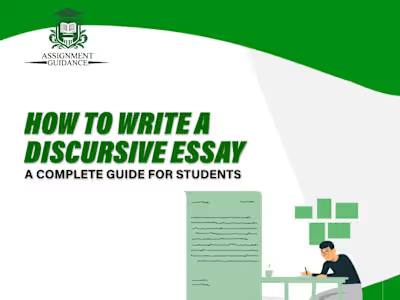Discursive Essay Writing Guidelines
A discursive essay is a challenge of its own because you have to discuss both sides of an issue or an argument. In contrast to a persuasive essay, in which the author tends to persuade the reader of a certain point, a discursive essay allows to objectively consider other points of view. That is why writers must be able to use a neutral tone, support arguments in a balanced way, and organise their essays well.
Nevertheless, students have major problems with frequent errors in creating a discursive essay. Lack of structure in the discursive essay or lack of proper use of connecting words may also obstruct the way the essay is structured and flows. We shall point out the mistakes that one should avoid when it comes to discursive essay writing in this blog. Here we will offer some practice guidelines on how to tackle such an essay, starting with the discursive form of the essay, up to making sure that your argument is both objective and rational. These traps can be identified and learned to be avoided to make your discursive essay more effective in quality and resulting in a successful piece of work that is well-rounded and well-thought-out.
Understanding the Discursive Essay Structure
To avoid mistakes in your discursive essay, the first thing to do is to learn its structure. The normal structure of a discursive essay is introductory, body paragraphs, and conclusion.
1. Introduction:
During the introduction, you need to quickly set the scene and state why the issue is important. When introducing this part, it is essential not to adopt a point of view since you are trying to precondition the arguments that you are going to state.
2. Body Paragraphs:
This is the section where the major arguments are given. When writing a discursive essay, it would be imperative to present a balanced presentation where you give both sides of the coin. You should treat each side equally in an equal document. The body is normally subdivided into a number of paragraphs, and each paragraph focuses on another aspect of the matter.
3. Conclusion:
At the end of the essay, you are going to summarize the major points that you have discussed in the essay. It is also the place where you may mention any kind of insight you have had in the course of your research without being firm about it.
1. Ignoring the Discursive Essay Structure
A discursive essay is one of the most popular genres in which students make a lot of mistakes. A disorganized and unreadable essay might be written by not using the regular format. The discursive essay format is aimed at letting the reader trace the flow of ideas and get the idea of the argument.
An essay that is properly structured needs to:
It should start with an introduction to prepare the topic.
In the body paragraphs, give arguments on both sides of the issue and give one side of the issue in each paragraph.
Leave the discussion with a conclusion that does not provide a definite stand.
Neglecting the structure, you run a risk of losing your reader and confusing him or her about the general line of arguments you are describing. Regardless of a particular essay, you should use the discursive essay format to make your essay organized, easy to read, and effective.
2. Failing to Present a Balanced Argument
A discursive essay is concerned with the investigation of a topic by taking it from different sides. There has to be a balance in how both sides of the argument are brought out. The biggest fault is bringing only one side of the argument and avoiding facing the counterarguments. This undermines the objectivity of your essay and could suggest the impression that you are biased towards one of the two views.
Remember to include the following to write a balanced argument:
Offer both sides without opinion.
Provide evidence to be presented to two sides of the argument.
Examine and elaborate on the evidence.
Keep the balance by not favoring one argument more than the other.
3. Introducing Bias into Your Essay
One of the most frequent pitfalls among students is bias in writing. Introducing bias in a discursive essay may result in impairing the effectiveness of your writing since the essay is intended to provide varied perspectives on an issue. When you start writing, it is very tempting to be influenced by your views, but as a writer, you must provide the facts and leave the reader to make his/her conclusions.
When you are composing your discursive essay then you must be extra cautious in excluding bias by ensuring:
Applying neutral language: Do NOT use statements that suggest subjectivity and emotional stunts.
Focusing on all sides of the debate with equal emphasis.
Giving credible sources of both points of view on the matter.
Avoiding combination or drivel words.
To keep the tone of the discursive writing formal, it is better to state the facts and state them straightforwardly, instead of trying to impose your own opinion.
4. Using Informal or Conversational Tone
Discursive writing requires some formality that allows confidence, maturity, and respectability to be upheld in your essay. Informal language or colloquial phrases may undermine your argument and turn your essay into a non-scholarly one. It is especially necessary in a discursive essay, where you have to be neutral and objective.
Here are the ways to arrive at a formal tone:
Avoid colloquial or conversational language (e.g., you know, stuff, really).
Make use of academic words that would depict your grasp of the topic.
Make your sentence structure simple. She should not use too hard or complicated phrases.
When writing a paper in a discursive way, always remember to adopt a formal tone; you will not only be enhancing the quality of your paper but will also be able to make your argument sound reasonable and well-informed.
5. Lack of Logical Flow and Coherence
The lack of logical connection between paragraphs and ideas is one of the mistakes that could easily take place in discursive writing. This occurs when the author fails to employ the right linking words or phrases to join thoughts. This is because, when the transitions are not smooth, the essay might turn out to be disjointed, and the reader will find it hard to follow the argument.
To advance the discursive flow of your essay, one can employ such linking words of discursive essays as:
Moreover, to point out some more.
Conversely, on the negative side of this picture, there is the mother.
But- to give an opposite meaning.
Besides, to have another supportive argument.
Nevertheless, to sound a contradiction.
Transitional words help the reader to follow the different parts of your essay, so the argument will have the sensation of being a true and structured discussion.
6. Overloading the Essay with Too Much Information
The other typical pitfall is to make your discursive essay over-stuffed with information. Although trying to support your arguments with evidence is important, you should not provide too much information that is not relevant or is not needed, so as you confuse the reader. It is significant to concentrate on the most relevant issues and make them short.
These are some of the ways to prevent information overload:
Regarding the main arguments and pieces of evidence in support of your topic.
Give understandable and definite examples instead of giving long explanations.
It is also advisable that you do not go off-topic or add irrelevant facts that do not aid your argument.
It is particularly important to be concise when writing a discursive essay because it makes your points easy to understand.
7. Ineffective Conclusion
A lot of learners have difficulties with the problem of ending a discursive essay in the right way. A conclusion must reflect all important things said in the essay and leave the reader with something to think over in a final thought. It is, however, common to see a person take a position or provide a definitive statement using the conclusion, which is against the objective basis of the discursive essay.
Discursive essays are concluded in the following way:
Paraphrase/state simply the primary arguments.
Consider the fact that the issue is quite complicated, and that both sides are right in their own way.
Do not bring out new arguments and evidence in the conclusion.
Encourage the reader to think and leave them with a statement to consider or areas to study more.
An end is a last chance to strengthen the balance and justice of a discursive essay, so do not forget to do it with the objective tone of your essay in mind.
Conclusion
To write a successful discursive essay, it’s crucial to understand its structure and format. Avoiding common mistakes will help you create a clear, cohesive, and unbiased piece. A discursive essay should present an issue as a debate, supporting both sides with evidence. Using a formal tone, linking words, and ensuring a logical flow of ideas will improve your writing. These elements will make your essay comprehensive and memorable to the reader. Finally, knowing how to end your discursive essay without arguing a point is key. A balanced conclusion ties up your essay well and leaves the reader with a clearer understanding of the issue.
Like this project
Posted Jun 24, 2025
Created guidelines for writing effective discursive essays.
Likes
0
Views
0
Timeline
Jun 24, 2025 - Aug 24, 2030






